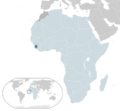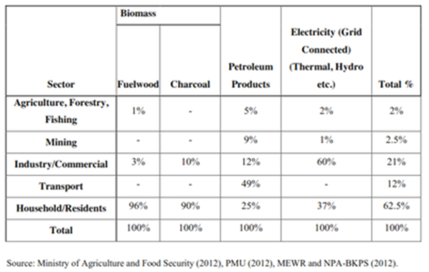Sierra Leone Energy Situation
Capital:
Freetown
Region:
Coordinates:
8.4844° N, 13.2344° W
Total Area (km²): It includes a country's total area, including areas under inland bodies of water and some coastal waterways.
72,300
Population: It is based on the de facto definition of population, which counts all residents regardless of legal status or citizenship--except for refugees not permanently settled in the country of asylum, who are generally considered part of the population of their country of origin.
8,605,718 (2022)
Rural Population (% of total population): It refers to people living in rural areas as defined by national statistical offices. It is calculated as the difference between total population and urban population.
56 (2022)
GDP (current US$): It is the sum of gross value added by all resident producers in the economy plus any product taxes and minus any subsidies not included in the value of the products. It is calculated without making deductions for depreciation of fabricated assets or for depletion and degradation of natural resources.
4,094,563,859 (2022)
GDP Per Capita (current US$): It is gross domestic product divided by midyear population
475.80 (2022)
Access to Electricity (% of population): It is the percentage of population with access to electricity.
27.49 (2021)
Energy Imports Net (% of energy use): It is estimated as energy use less production, both measured in oil equivalents. A negative value indicates that the country is a net exporter. Energy use refers to use of primary energy before transformation to other end-use fuels, which is equal to indigenous production plus imports and stock changes, minus exports and fuels supplied to ships and aircraft engaged in international transport.
no data
Fossil Fuel Energy Consumption (% of total): It comprises coal, oil, petroleum, and natural gas products.
no data
Introduction
Very few people have access to electricity in Sierra Leone: Approximately 10% to 12% of the urban population and only around 2% of the rural population. Petrol or diesel generators are often used because most of the regions lack a stable public power supply. Kerosene, battery lamps or candles are mainly used for lighting. 96,8% of the population cooks with firewood or charcoal. There is significant potential for the use of renewable energy, particularly solar energy and hydroelectric power.
Energy Situation / Statistics
“Energy statistics are difficult to obtain in Sierra Leone, especially for renewable energy. Although the conventional thermal energy production and consumption patterns have been reported, no consolidated set of statistics exists for the total Energy situation of Sierra Leone.[1]
This is also reflected in international reports, such as the “Renewable Energy Statistics 2017” report by IRENA, where the solar power capacity for Sierra Leone is claimed to be 0MW.
EnDev has signed a MoU to assist the Ministry of Energy in Sierra Leone with data collection, but information is difficult to obtain, since different private sector stakeholders are reluctant to share data.
Sierra Leone’s power sector is small, with less than 150 MW of operational capacity and roughly 150,000 connected customers.
The biggest grids are:
- The 161kv line that extends to Freetown and the surrounding Western Area , covering about 40% of their residents. The power is provided by the Bumbuna hydro power plant, situated aprox. 220km from Freetown.
- The Makeni grid, providing electricity to the town of Makeni in Port Loko District. The power is also provided by the Bumbuna hydro power plant.
- The 33kv electricity line, or Bo-Kenema, which provides electricity to the towns Bo and Kenema, the capitals of Bo and Kenema Districts in the southeast of the country.
The costs for electricity are highly subsidised by the Government and rate aprox. 1000 Leones (0,13 EUR) per kWh for private households, up to 0,23 EUR/kWh for industry.
Overall Energy Use
- 80% Biomass (mainly for cooking): Wood and Charcoal
- 13% Petroleum products (mainly for transport, lighting and private energy generation, all petroleum is imported)
- Grid connected energy accounts for the remaining energy
- Most of the energy is used in households
Renewable Energy
“The country possesses vast potential in renewable energy in the form of biomass from agricultural wastes, hydro and solar power, which remain virtually untapped.”[2]
According to the “Renewable Energy Statistics 2017” report by IRENA there is a total capacity of 88 MW of Renewable Energy in the country, of which 56 MW are Hydro Power and 33 MW Bioenergy. However, as lined out above, data are incomplete. For example, Solar Energy is not included in the statistics.
According to the Ministry of Energy, the share of Renewables was 78,4% in 2013.
Ministry of Energy 2015, Sustainable Energy for All (SE4ALL) Action Agenda for Sierra Leone
Hydro Power
According to the “Renewable Energy Statistics 2017” report by IRENA, Sierra Leone has 56 MW hydro power capacity.
The biggest hydro power plant is situated in Bumbuna, at around 220km distance from Freetown in Tonkolili District, covering aprox. 40% of the capitals' residents. In wet season the Bumbuna hydro power plant generates aprox. 30-40MW and in the dry season 10-18MW, leading to frequent power blackouts in the months from February to April.
Nevertheless, the importance of the hydro power plant is reflected on the 5.000 Leones note, depicting the Bumbuna reservoir.
In the end of 2017, the parliament of Sierra Leone approved the so called "Bumunba II", an extension of Bumbuna I, adding a further 143MW of power capacity. [1]
The bigger cities of Bo, Kenema and Makeni are also provided with hydro power.
According to the German Bundesministerium für Wirtschaft und Energie, there is potential for 2.000MW of hydro power. Faktsheet Republik Sierra Leone
Solar Energy
In February 2017 Sierra Leone was the first African country to sign the "Energy Africa Policy Compact" with the Government of the UK. As part of the compact, the Energy Revolution initiative was launched, committing to reach 250.000 households with modern energy solutions by 2018. A task force was established and within government and private sector the focus shifted notably to renewable energy, especially solar energy.
According to the “Renewable Energy Statistics 2017” report by IRENA, there is no solar power capacity installed in Sierra Leone. Nevertheless, in the years from 2014 to 2018 two bigger projects have been implemented:
- Promoting Renewable Energy Services for Social Development (PRESSD) (2014-2018): Installation and operation of 3 solar mini-grids in Segbwema, Panguma and Gbinti, installation of SHS for aprox. 100 charging centres, 20 energy hubs for Agricultural Business Centres, 20 clinics, 12 schools, 12 finanical service associations. Equipment and training for 3 Energy Laboratories in cooperation with Polytechnics. Sales of Pico PV products through local retailers. Partners: European Union, Welthungerhilfe, Cooperazione Internationale, Energy for Opportunity, Oxfam.
- Rural Renewable Energy Project (2017-2020): Installation of a total of 50 smaller (6-36KW) mini-grids and 40 bigger (>36KW) mini-grids, located at health facilities. Development of private companies operation model. Partners: UNOPS, UK Aid.
Smaller projects include:
- WASH Consortium:Implementation of solar water pumps for decentralized water supplies. Partners: DFID, Oxfam, Concern, Save the Children, Action against Hunger.
- Biodiversity Conservation Project: Solar Charging Centres to support Biodiversity Conservation. Partners: GEF, World Bank
- Apex Bank Solar Systems: Provision of SHS for Financial Service Associations and Community Banks. Partners: Kafeibu Constructions, IFAD.
- Advancing Partners and Communities: Solar systems for health facilities. Partners: USAID, JICA, JSI, ACF.
- Barefoot Women Solar College: Training centre, courses for illiterate women, installation of Solar Systems for communities. Partners: Barefoot Women, Ministry of Energy.
- Playhouse Foundation/EnDev: SHS for health facilities and schools in Kono and Kailahun.
- Rural Energy Activating Livelihoods (REAL):Provision of electricity and employment options (charging centre) to rural population. Partners. Environmental Foundation for Africa, EU.
Biomass
Energy consumption in Sierra Leone is dominated by biomass, which accounts for over 80% of energy used. The largest source of biomass energy is wood fuel followed by charcoal [3]. According to IRENA, “Renewable Energy Statistics 2017” report by IRENA Sierra Leone has a capacity of 33MW, generated from Biomass.
According to the German Bundesministerium für Wirtschaft und Energie, the theoretical potential for the use of Biomass is 2.706GWh. Faktsheet Republik Sierra Leone
Biomass for Cooking
According to the 2015 Population and Housing Census [4]., 96,8 % of the population in Sierra Leone uses firewood or charcoal for cooking. Other sources, including gas, kerosene or electricity account for the remaining 3,2%. 64,7% of the households use firewood and 32,1% use charcoal on a national level. The percentages vary from district to district. In the Northern, Eastern and Southern regions, an average of 83,7% of the population cooks with firewood and an average of 14,5% uses charcoal . In the Western Region, where the capital Freetown is situated, 83,3% of the households use charcoal as the main source of energy for cooking, 8,9% use wood and 7,8% other sources. By way of conclusion, the main energy source for cooking in rural areas is firewood, the main energy source for cooking in urban areas, especially in Freetown, is charcoal. Families who cook with firewood make 3-stone-fires. In urban centres of Sierra Leone, the 3-stone-fires are gradually replaced by clay stoves and metal coal pots in parallel. But, it is noteworthy that 3-stone-fires still play an important role, even in urban centres, because the preparation of food with a longer preparation time (i.e. for festivities), is normally done with a 3-stone-fire.
Awareness on Improved Cook Stoves is still to be raised, even though many people in bigger cities cook with locally made clay stoves which save fuel compared to the traditional metal coal pots used in other West African countries.
Westwind Energy produces the "Wonder Stove" in a local clay and metal workshop in Freetown. It fulfills criteria for Improved Cook Stoves, according to tests that EnDev conducted.
Fossil Fuel
After Biomass, imported Petroleum Products are the next largest source of power at approximately 13%. Petroleum products importation has been done through refined products like Gasoline or Petrol, Diesel, Marine Fuel Oil, Kerosene, due to the absence of a domestic refinery. The Petroleum Products are consumed mainly in the transport and residential sector. Sierra Leone currently imports all its petroleum products. Petroleum Product importation volume per annum increased by more than 100% between 2000 and 2011. Petroleum products consumption averaged 184,290toe per annum. There is one big thermal oil plant with an installed capacity of 37MW. [5]
Policy Framework, Laws and Regulations
Institutional Set up in the Energy Sector
Key Problems of the Energy Sector
- Financing/Investment
- Building up Infrastructure (Transmission and Distribution Networks)
- Many parts of the country have no grid access
- Network is very old (50 years) and many distribution lines were destroyed during the civil war
- This has led to large private sector generation, especially in industry. Many companies are forced to rely on diesel generators
- Generation capacity does not cover the demand
- Poor Energy Efficiency (both in terms of electricity generation and distribution as well as with biofuels/kerosene used for cooking and lighting)
- Old equipment
- No energy audits/benchmarking
- Inefficient cooking stoves + kerosene lights
Further Information
- A much more detailed report on the energy situation is provided in the National Energy Profile of Sierra Leone, published by the UN in 2012
- For a full overview of energy policies see: Sierra Leone Energy Africa Compact, published by Energy Africa
- Useful IRENA mapping tool for seeing the wind and solar potential in Sierra Leone
- A website on the Renewable Energy Sector in Sierra Leone was developped by EnDev and partners Renewables Salone.
References
- ↑ UNDP, 2012. National Energy Profile pf Sierra Leone, s.l.: UNDP.
- ↑ UNDP, 2012. National Energy Profile pf Sierra Leone, s.l.: UNDP.
- ↑ UNDP, 2012. National Energy Profile pf Sierra Leone, s.l.: UNDP.
- ↑ Statistics Sierra Leone,2015 Population and Housing Census.
- ↑ UNDP, 2012. National Energy Profile pf Sierra Leone, s.l.: UNDP.
- ↑ UNDP, 2012. National Energy Profile pf Sierra Leone, s.l.: UNDP.






















